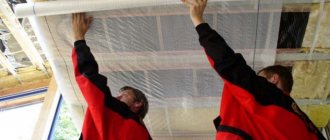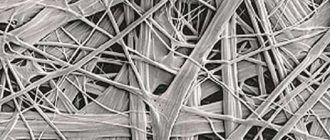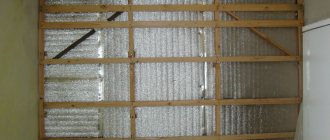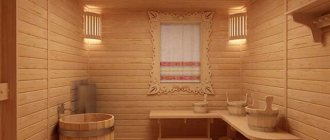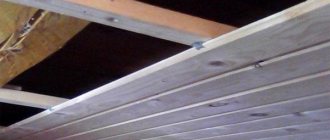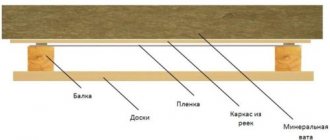With the development of technology, the requirements for housing comfort are increasing, which depends on many factors, including the state of the environment inside the home. Room temperature, air humidity, noise level, illumination - all these are components that characterize living conditions. Comfortable values of these parameters are achieved by using materials with appropriate characteristics in construction and finishing. At the same time, multifunctional materials provide not only comfortable living, but also the efficiency of using other special finishing products.
Let's consider the importance of performing a vapor barrier in a room, the modern vapor barrier material "Izospan", and how to lay isospan on the ceiling - the base that is in contact with steam more than other structures.
What is isospan
In rooms with high humidity or enclosing structures insulated with soft thermal insulation materials, a vapor barrier is required.
The simplest vapor protection of foundations is provided by a shell made of roofing material or polyethylene, which simultaneously serves as a waterproofing material. But such a primitive double-sided barrier does not allow moisture evaporating from the base material and insulation to pass out. In addition, drops of condensation formed on the film flow down or fall down without having time to evaporate, forming puddles on the floor and streaks on the walls.
Modern vapor barrier materials are much more functional; their varieties are produced for a specific task and therefore, while providing vapor protection, are free from the listed disadvantages.
By protecting the base from contact with condensate, the vapor barrier performs the following functions:
- protects the base from contact with condensate, preventing the formation of fungus;
- isolates the base insulation from external moisture, maintaining its thermal insulation properties;
- allows the water originally contained in the materials of the supporting structure and thermal insulation to evaporate;
- traps condensate, preventing it from draining and ensuring gradual evaporation.
An example of a modern vapor barrier material is the products that have been produced for 12 years by the domestic LLC Hexa - Nonwoven Materials under the brand name Izospan.
Izospan is a diffusion film or membrane made from modern polymers, produced using special technologies that make it possible to provide the varieties of this vapor barrier with certain characteristics, which, given the wide choice of insulating materials, facilitates the selection of a product with the desired functionality. The format and strength of isospan are designed in such a way that the installation of the vapor barrier shell can be carried out with optimal performance and quality.
Types, characteristics and applications of isospan
All types of isospan produced are made of polypropylene and are divided into 4 capacious lines, differing in characteristics and functionality:
- vapor-permeable, but waterproofing and wind-protecting membranes (5 classes - A, A with OZD - fire retardant additives, AQ proff, AM, AS;
- films with vapor and waterproofing properties (6 classes - RS, B, C, RM, D, DM);
- energy-saving heat-steam-waterproofing materials with reflective coating (4 classes - FB, FS, FD, FX);
- adhesive tapes (7 types - KL, KL+, SL, FL, FL Termo, ML proff, SUL - self-adhesive sealing tape).
Materials of all varieties have the following common advantages:
- the required degree of vapor permeability;
- sufficient degree of tensile and bursting strength;
- environmental friendliness and safety - no harmful emissions;
- the presence in each group of fire-fighting varieties that have self-extinguishing properties;
- manufacturability due to elasticity, ease of cutting and optimal format for installation.
To simplify the overview of the varieties listed above, let's consider 4 types of isospan, the most widely used for vapor barrier - marked on the packaging as A, B, C and D. But this does not mean that other modifications of isospan are not suitable for vapor barrier - on the contrary, they either have higher performance, or designed for specific operating conditions. You just need to know how to choose and correctly lay these types of isospan on the ceiling.
Izospan type A
“Izospan A” is produced in two types – wall and roofing.
Roofing isospan-A is a wind- and moisture-insulating, but vapor-permeable membrane, laid between the roof insulation and its decking (metal tiles, cement-bonded particle board, ondulin). This shell is designed to prevent the formation of under-roof condensation, as well as to protect insulation and sloping roof structures of buildings with an inclination angle of more than 35 degrees from it.
The outer side of group “A” isospan is smooth, has water-repellent properties and is resistant to ultraviolet radiation. The structure of the inner surface of the membrane is voluminous, preventing the formation of condensation and allowing water vapor from the insulation to erode out.
A more advanced variety with a slightly lower vapor permeability value (at least 850 g/m2/day), but lighter and three times more water-resistant, is the Izospan AM vapor barrier.
Izospan type B
Izospan B is a universal two-layer protection of insulation and building structures from steam in the internal environment, which also has waterproofing properties. The material is laid on the inside of the heat-insulating layer of attic, basement and interfloor ceilings, as well as soft roofing. “Izospan-V” is placed with its smooth side facing the thermal insulation layer, and the rough outer surface with this arrangement helps to retain condensate on it with subsequent evaporation into the air of the room.
Izospan type C
“Izospan-S” is also a two-layer material for providing double-sided vapor and water protection for insulated coverings and floors, but its high strength allows the material to be used as a waterproofing layer on concrete, earthen and other insulated floors.
Izospan type D
This type of vapor-waterproofing isospan has increased strength, as it is made on the basis of polypropylene woven fabric. The high tensile strength characteristics of isospan-D make it possible to use this material to insulate building structures from the effects of atmospheric moisture from the outside, while the insulating coating can be exposed to even a static snow load.
Like “Izospan-S”, D-type vapor barrier can be used as a waterproofing shell on concrete and earthen floors, but its general application is hydro- and vapor barrier in two directions, protection from snow and wind of cold and insulated pitched roofs and wooden structures , as well as roofing covering from condensation from the inside.
Material properties
Polymer-type membranes have earned positive reviews due to their room protection properties:
- Ability to conduct heat.
- High density due to membrane type structure.
- Waterproof.
- Strength, resistance to external influences, breakthroughs.
- Ability to protect against ultraviolet rays.
- Modern technologies make it possible to produce building materials with a high degree of environmental safety - this applies to all types of isospan.
Common technologies for vapor barrier of ceilings with isospan
Vapor barrier of the ceiling base is carried out using one or a combination of several types of this vapor barrier, and the installation of any isospan on the ceiling can be done independently. The individual characteristics of the varieties of this vapor barrier material are indicated on the packaging, which makes it easier to select the protection of the desired class. When selecting the right brand of isospan, it is necessary to take into account the functionality of the ceiling (basement, interfloor or attic), its material, type of insulation and operating conditions of the room. The location of the vapor barrier shell relative to the base and insulation is also of great importance, since a correctly executed vapor barrier is also based on the orientation of the material used.
How to lay isospan on a concrete ceiling
When repairing the ceiling, an intermediate operation, performed after leveling with cement mixtures and before insulating the base from the inside, is waterproofing - in case of leakage from above, if there are highways or plumbing fixtures on the floor above. A layer of waterproofing applied to the ceiling from the room side using a coating method (deep penetration composition or bitumen-based) will simultaneously perform the function of vapor barrier, which is mandatory when using soft insulation. The coating method of waterproofing, which is not difficult to implement, eliminates the need to lay a layer of isospan-A on the ceiling, the waterproofing properties of which are also lower.
When installing thermal protection made of rigid insulation (polyurethane foam, expanded polystyrene) over waterproofing, there is no need to install a vapor barrier. But if mineral wool is used for insulation, especially when laid in a frameless manner (plastic fungi), then a vapor barrier is required - this insulation is hygroscopic and, in addition to reducing its thermal insulation qualities, will also “please” it by reducing its thermal insulation qualities.
Soft insulation is mounted on a waterproofed ceiling using plastic mushrooms in such a way that the fastener caps press the thermal insulation layer along with a vapor barrier made of isospan-B to the concrete base. Izospan is laid in strips with an overlap of 15 cm over each other, and on the ceiling - 5-10 cm down, with the smooth side towards the insulation. The edges of the overlaps are glued longitudinally with self-adhesive Izospan tape of FL or SL brands.
On the ceiling, the location of insulation sheets with fungi is first marked so that the longitudinal rows of fasteners are arranged in even parallel rows with the same spacing. Wooden slats treated with a hydrophobic compound are installed along the longitudinal rows of fungi, attaching them to plastic caps using self-tapping screws. Decorative plastic panels or siding can be laid across longitudinally mounted slats.
Manufacturer company
All categories of Izospan are manufactured by Izospan, which has its own production facility in the Tver region. The company produces various membrane films with vapor barrier, moisture-repellent and energy-saving properties.
Products undergo strict quality control at all stages of production and have international certificates of conformity. Thanks to these features, the products are in consistently high demand in the domestic and European markets.
Installation of isospan in the interfloor ceiling
If both floors are residential, that is, heated, the vapor barrier can be done using only one type of material - isospan-B, but it will be laid on both sides of soft insulation
When installing interfloor ceilings on load-bearing beams, rough ceiling boards are hemmed to them from below. Then, on the rough ceiling from the side of the upper floor, soft insulation is laid between the beams, the thickness of which should be 3-5 cm less than the cross-sectional height of the rafters. This difference in size is necessary so that after laying the vapor barrier film on top, a ventilation gap is formed between the isospan and the thermal insulation, necessary for weathering moisture from mineral wool.
Isospan-B is spread over the heat-insulating layer - with the smooth side towards the insulation. The vapor barrier film is attached to the beams with staples using a stapler, avoiding strong tension or sagging, with the strips overlapping each other by 10-15 cm, with the joints between each other and the walls being glued with connecting tape “Izospan-SL” or “-FL”.
Counter slats are nailed on top of the rafters along their entire length - wooden blocks with a cross section of 4x4 or 5x5 cm, across which the finished floor boards are laid.
Important! After finishing laying the finished floor, it is necessary to check and, if necessary, tamp down the rough ceiling boards from below, the fastening of which may become loose due to knocking on the rafters from above.
Then they begin to install the vapor barrier on the rough ceiling, which is done according to the same rules: using a stapler with staples across the ceiling boards, the volumetric side of the isospan-B towards the room, with an overlap of vapor barrier strips of 10-15 cm.
Upon completion of the vapor barrier device, finishing is performed foundations with siding.
We recommend visiting the company’s website for wholesale and retail sale of lumber https://www.realwood.ru/. Larch, pine, spruce. Quality products.
Required Tools
Devices for such work can be found in every private home, and even in the pantry of a thrifty resident of a high-rise building. To secure the strips, you will need a construction stapler with staples and a hammer complete with wide-headed nails. The first is used when working around the perimeter, and the second when you have to work in hard-to-reach places. You cannot do without a well-sharpened knife and scissors for cutting the film.
It is better to take self-adhesive tape of the same brand in order to completely eliminate possible holes that violate the seal. After tensioning, the slats are stuffed onto the already tensioned Izospan (with a large surface). You also need to take care of their purchase in advance.
Installation of isospan when installing roof coverings
This situation differs from the previous one in that above the coating there is an external environment with all the accompanying factors - wind, rain, snow, etc. In addition, when choosing the type of isospan in this case, you should also take into account the roof structure, which can be flat or sloped.
Vapor protection of a wooden ceiling under a roof with a slope
Wooden slats with a cross-section of approximately 3x6 cm are placed across the roof rafters from below in increments of 0.5 m, on which soft insulation is laid on top. An additional sheathing of slats is placed on top of the insulation in order to lay a vapor barrier made of isospan-A on it. A-class isospan is designed to protect insulation and roof structures from wind, snow and rain, but its smooth surface is not laminated, as it is intended for use on roofs with a slope of more than 35 degrees, at which water drops roll down. Additional sheathing is performed to ensure this slope angle, so that such a film does not sag over time and does not let water through into the insulation.
It is spread over the sheathing and isospan-A is attached to it according to the method described above. Next, counter battens are sewn along the rafters, on top of which the sheathing for the outer roof covering is mounted.
On the inside of the covering, an isospan-B vapor barrier is spread and stapled onto transverse slats with a cross-section of 3x6 cm, on top of which the interior siding trim is mounted in the direction perpendicular to the location of the bars.
Thus, the soft insulation is insulated on both sides with different types of isospan, also providing a double-sided ventilation gap:
- Izospan-A protects insulation and structures from wind, sub-roof condensation, rain and snow, without preventing moisture from escaping in the opposite direction from the insulation and structural materials;
- Izospan-B insulates soft thermal insulation from moisture contained in the room air.
Vapor protection of a wooden ceiling under a flat roof
The design of the vapor barrier on the ceilings of this roof structure is somewhat different from the vapor barrier device of the previous type of coating. Since the smooth surface of isospan-AM is laminated, its strength and waterproofing characteristics are much higher than type A vapor barrier, therefore AM vapor barrier can be used when the roof slope is less than 35 degrees and even on flat bases. In this case, there is no need to install additional sheathing on top of the insulation - the strength of isospan-AM itself is sufficient, but for this it must be correctly laid, fastened and joined.

